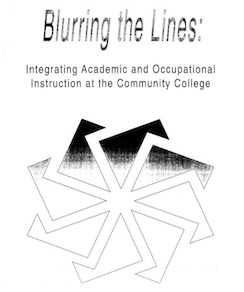Within my first month as a newcomer to Illinois I heard more than one person mention a “Blurring the Lines” report when discussing practices to support student learning in career and technical education programs. After some digging, I managed to locate a copy of this report (here). Written in 1997 by the Illinois Task Force on Academic/Occupational Integration, this publication’s full title is Blurring the Lines: Integrating Academic and Occupational Instruction at the Community College. I found that although this report is 18 years old, it is also completely relevant to our work today.
Blurring the Lines mirrors national conversations about the quality and equity of workforce preparation; “stackable” credentials that lead students from a certificate in a technical field, to an associate’s, and finally to a bachelor’s degree and beyond; and the value of high-impact practices touted by organizations like the Center for Community College Student Engagement or the Association of American Colleges & Universities. The report details specific practices that can improve student engagement and meaningful learning in community college career and technical programs through integration of technical learning with academic content, team learning, or work/community-based experiences. Key practices listed in this report could come straight from current research on high-impact practices that improve student learning and retention: learning communities, contextualized curriculum (a hot topic in developmental education reform), linked courses that allow students to apply skills and learning in multiple settings, capstone courses and projects, work-based learning or internships, and interactive class experiences.
We know from a growing body of national research that these types of practices show promise to close achievement gaps for our growing population of diverse learners. Most importantly, we also know that students of color and low-income students are often less likely to engage in such practices due to issues related to enrollment stratification and funding.
Reviewing this report brings to the forefront a pressing issue that demands our attention in the Pathways to Results (PTR) process: if engagement in integrative learning experiences enhances student success and prepares students to enter and advance in the workforce, how are we consistently supporting community college teams to use data to explore student access to and benefit from such programming? Some teams have tackled this issue, but how can the PTR process open up this question for each and every team?
PTR has the potential to take community colleges farther into the realm of high-impact practices, and I strongly encourage this direction. Such inquiry takes a step beyond assessing retention or completion into the complex territory of student preparation for long-term success, including focusing on integrated soft and analytical skills needed for future educational endeavors and for equitable advancement in the workforce. The inherent complexity of assessing integrative learning opportunities is daunting, but PTR is poised to delve into this arena. The PTR process can do more to advance practices with demonstrated equitable outcomes. As dozens of PTR teams have already learned by analyzing disaggregated student-level data, inequities in student outcomes are not insurmountable when armed with the right tools.
This blog is part two of three in a blog series exploring the expansion of the PTR lens. We hope those of you who are a part of the OCCRL and PTR networks will continue to send us and your input and ideas.
Heather McCambly is the Project Coordinator for the Pathways to Results Initiative at the Office of Community College Research and Leadership (OCCRL). Prior to moving to Illinois, Heather was a Program Associate in the Office of Diversity, Equity, and Student Success at the Association of American Colleges and Universities.
